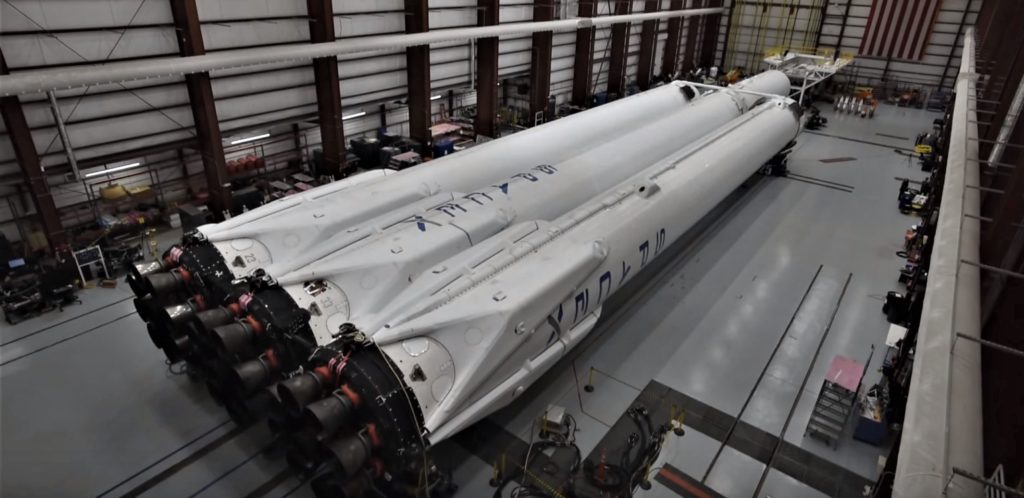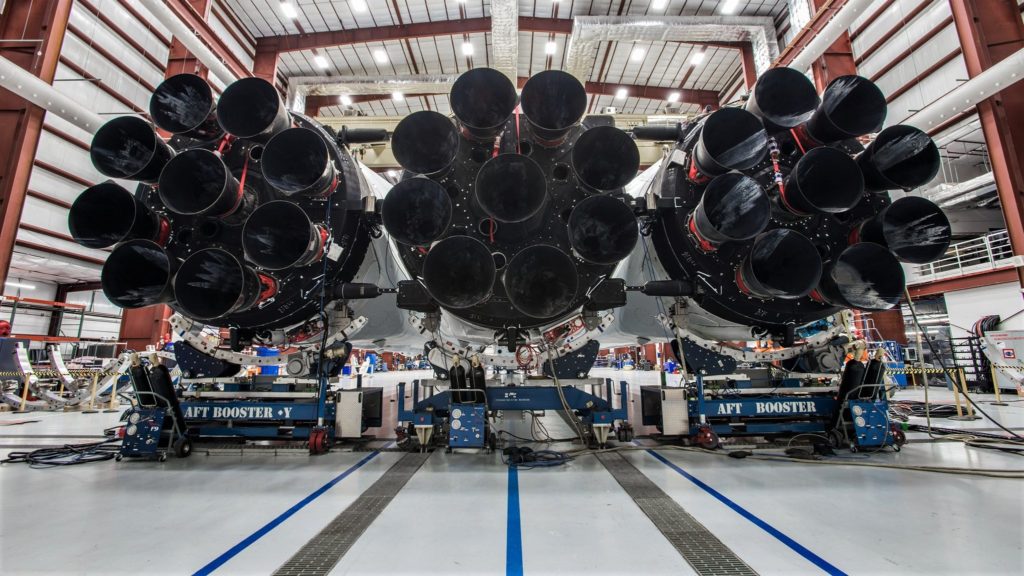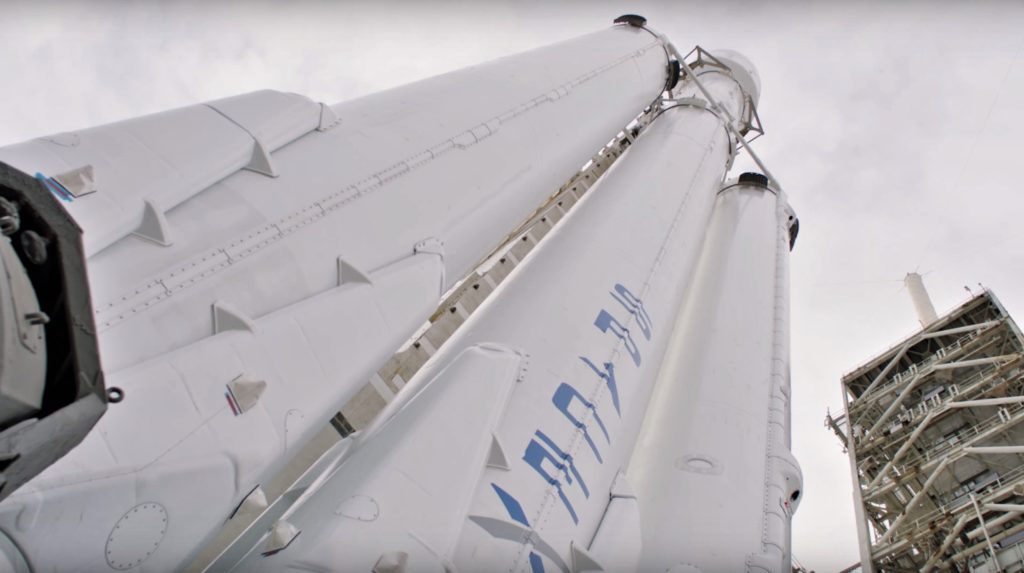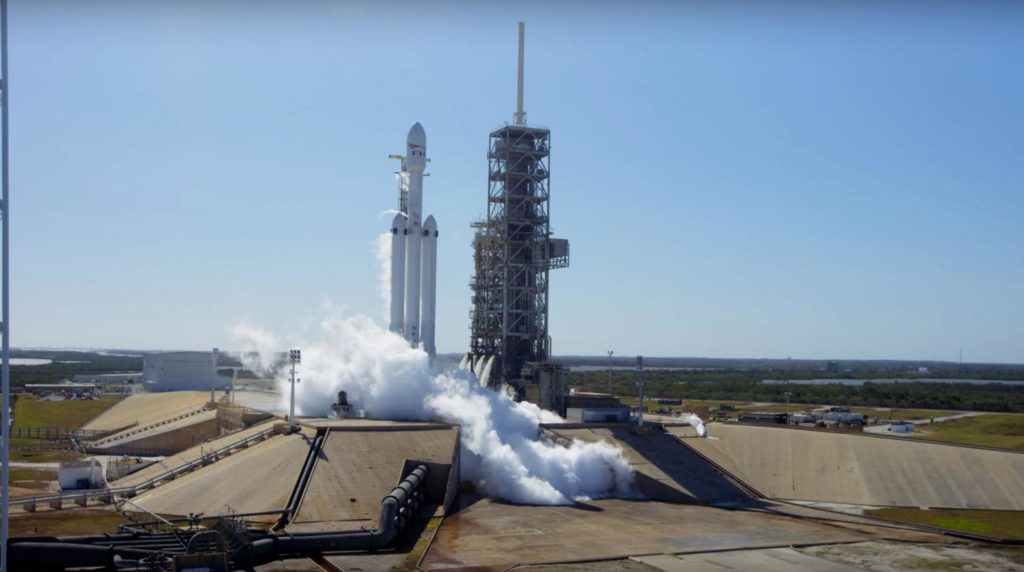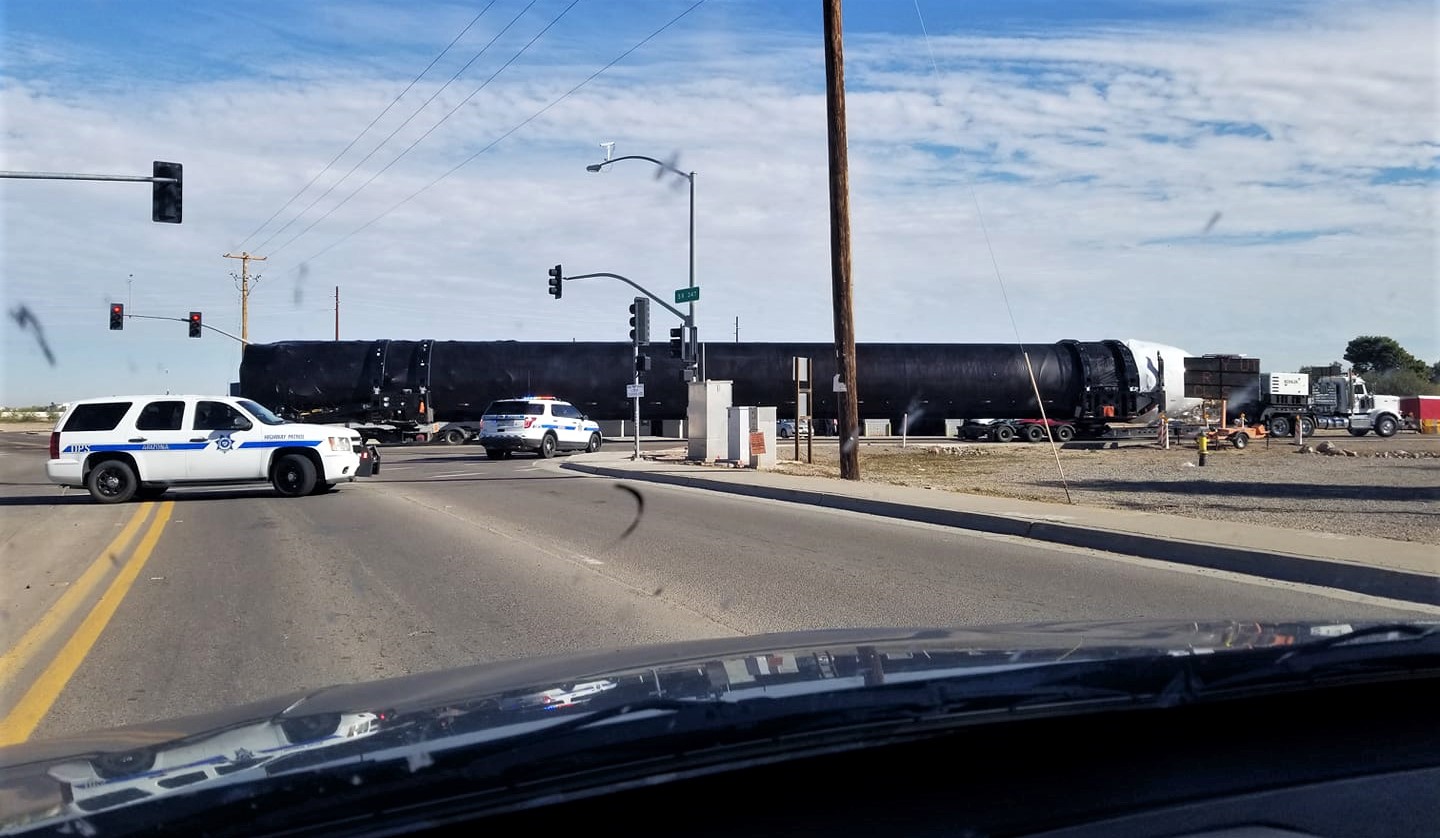
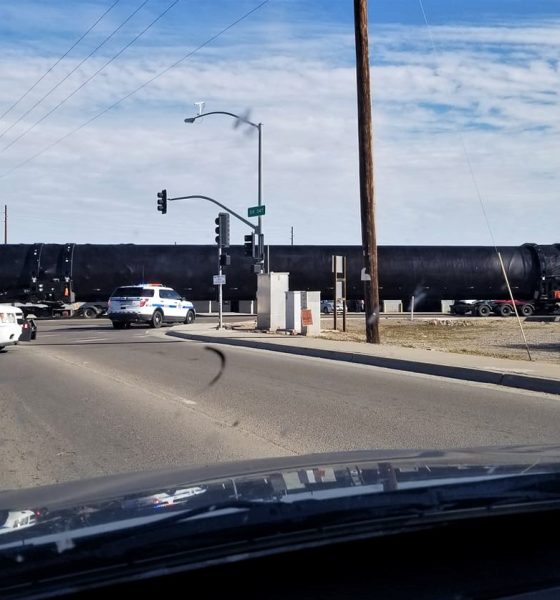
News
SpaceX’s next Falcon Heavy two-thirds done as side booster #2 leaves factory
First posted to a SpaceX-focused Facebook group by member Eric Schmidt, Falcon Heavy Flight 2’s second side booster (of two) was spotted eastbound in Arizona on December 3rd, partway through a journey from SpaceX’s Hawthorne, CA factory to its McGregor, TX testing facilities.
This is the second (known) Falcon Heavy-related booster spotted in less than a month and an incontrovertible sign that the company’s second-ever Falcon Heavy launch is perhaps just a handful of months away, with both side boosters now likely to be present in Florida by January 2019 barring unforeseen developments.
Look who was waving at passing planes over McGregor today!
A Falcon Heavy side booster on the McGregor test stand for a static fire test. pic.twitter.com/S7af6b0gHk
— NSF – NASASpaceflight.com (@NASASpaceflight) November 18, 2018
This second booster appearance follows on the heels of the first Falcon Heavy booster spotting on November 9-10, confirming that – at a minimum – two of the next rocket’s three first stage boosters have finish production and are now focused on completing their separate hot-fire acceptance tests at McGregor. Owing to the ironic fact that the center core – dramatically more complex than its pointy-nosed side core brethren – is far harder to discern while in transport, it’s even possible that the second side core spotting is actually the third new Falcon Heavy booster to depart SpaceX’s factory. The above booster was apparently the second SpaceX first stage to make its way east through Arizona in the week prior to its arrival, so that may well be the case.
SpaceX's second Falcon Heavy is slowly but surely coming together 😀 https://t.co/AYJsQ8Mld5
— Eric Ralph (@13ericralph31) November 13, 2018
While Falcon Heavy side boosters do sport easily recognizable nosecones, they apparently are able to be modified from a Falcon 9 booster to a side booster with no more than a week or two’s work. On the other hand, the rocket’s center booster is dramatically more complex and requires an entirely new custom rocket be built from scratch thanks to the extreme loads it must survive when the two side boosters channel all of their thrust directly into the center core during launch.
However, until the arm-like mechanisms that connect the center stage to its two side boosters are attached, it’s extremely difficult to discern between a normal Falcon 9 booster and a Falcon Heavy center stage. Until a center core is more or less unwrapped and showing off its octaweb or unusual bumps around the interstage, its identity is likely to remain a secret. In the past three months, no fewer than four Falcon boosters arrived at Cape Canaveral, while only one (or maybe two) of them have launched in the time since their arrival.
- SpaceX’s first Falcon Heavy prepares for launch. (SpaceX)
- Falcon Heavy ahead of its inaugural launch. (SpaceX)
- SpaceX’s Falcon Heavy prepares for the huge rocket’s inaugural launch. (SpaceX)
- Falcon Heavy just prior to its first-ever integrated static fire test. (SpaceX)
Given that both side boosters have traveled from California to McGregor, it’s almost certain that Falcon Heavy will fly for the second time with all-new Block 5 hardware, including all three boosters and the upper stage. Most importantly, a Block 5 version of the non-interchangeable center stage should ultimately be able to launch multiple times with zero or minimal refurbishment and repairs, potentially making Falcon Heavy for more viable from a production and internal cost perspective. For a rocket that may only ever launch twice per year, one or two custom center cores could be all that is needed over the vehicle’s operational lifetime, save for any potential launch contract that requires expendable performance.
Ultimately, this second Falcon Heavy booster spotting in less than four weeks is a thrilling sign that SpaceX is pushing extremely hard to have the rocket’s next iteration integrated and ready to launch as soon as possible, perhaps as early as Q1 2019. As its two side boosters begin to arrive in Florida, we should start to have a better idea of when exactly the massive rocket’s second launch might be.
For prompt updates, on-the-ground perspectives, and unique glimpses of SpaceX’s rocket recovery fleet check out our brand new LaunchPad and LandingZone newsletters!

Elon Musk
Elon Musk’s X will start using a Tesla-like software update strategy
The initiative seems designed to accelerate updates to the social media platform, while maintaining maximum transparency.

Elon Musk’s social media platform X will adopt a Tesla-esque approach to software updates for its algorithm.
The initiative seems designed to accelerate updates to the social media platform, while maintaining maximum transparency.
X’s updates to its updates
As per Musk in a post on X, the social media company will be making a new algorithm to determine what organic and advertising posts are recommended to users. These updates would then be repeated every four weeks.
“We will make the new 𝕏 algorithm, including all code used to determine what organic and advertising posts are recommended to users, open source in 7 days. This will be repeated every 4 weeks, with comprehensive developer notes, to help you understand what changed,” Musk wrote in his post.
The initiative somewhat mirrors Tesla’s over-the-air update model, where vehicle software is regularly refined and pushed to users with detailed release notes. This should allow users to better understand the details of X’s every update and foster a healthy feedback loop for the social media platform.
xAI and X
X, formerly Twitter, has been acquired by Elon Musk’s artificial intelligence startup, xAI last year. Since then, xAI has seen a rapid rise in valuation. Following the company’s the company’s upsized $20 billion Series E funding round, estimates now suggest that xAI is worth tens about $230 to $235 billion. That’s several times larger than Tesla when Elon Musk received his controversial 2018 CEO Performance Award.
As per xAI, the Series E funding round attracted a diverse group of investors, including Valor Equity Partners, Stepstone Group, Fidelity Management & Research Company, Qatar Investment Authority, MGX, and Baron Capital Group, among others. Strategic partners NVIDIA and Cisco Investments also continued support for building the world’s largest GPU clusters.
News
Tesla FSD Supervised wins MotorTrend’s Best Driver Assistance Award
The decision marks a notable reversal for the publication from prior years, with judges citing major real-world improvements that pushed Tesla’s latest FSD software ahead of every competing ADAS system.

Tesla’s Full Self-Driving (Supervised) system has been named the best driver-assistance technology on the market, earning top honors at the 2026 MotorTrend Best Tech Awards.
The decision marks a notable reversal for the publication from prior years, with judges citing major real-world improvements that pushed Tesla’s latest FSD software ahead of every competing ADAS system. And it wasn’t even close.
MotorTrend reverses course
MotorTrend awarded Tesla FSD (Supervised) its 2026 Best Tech Driver Assistance title after extensive testing of the latest v14 software. The publication acknowledged that it had previously criticized earlier versions of FSD for erratic behavior and near-miss incidents, ultimately favoring rivals such as GM’s Super Cruise in earlier evaluations.
According to MotorTrend, the newest iteration of FSD resolved many of those shortcomings. Testers said v14 showed far smoother behavior in complex urban scenarios, including unprotected left turns, traffic circles, emergency vehicles, and dense city streets. While the system still requires constant driver supervision, judges concluded that no other advanced driver-assistance system currently matches its breadth of capability.
Unlike rival systems that rely on combinations of cameras, radar, lidar, and mapped highways, Tesla’s FSD operates using a camera-only approach and is capable of driving on city streets, rural roads, and freeways. MotorTrend stated that pure utility, the ability to handle nearly all road types, ultimately separated FSD from competitors like Ford BlueCruise, GM Super Cruise, and BMW’s Highway Assistant.
High cost and high capability
MotorTrend also addressed FSD’s pricing, which remains significantly higher than rival systems. Tesla currently charges $8,000 for a one-time purchase or $99 per month for a subscription, compared with far lower upfront and subscription costs from other automakers. The publication noted that the premium is justified given FSD’s unmatched scope and continuous software evolution.
Safety remained a central focus of the evaluation. While testers reported collision-free operation over thousands of miles, they noted ongoing concerns around FSD’s configurable driving modes, including options that allow aggressive driving and speeds beyond posted limits. MotorTrend emphasized that, like all Level 2 systems, FSD still depends on a fully attentive human driver at all times.
Despite those caveats, the publication concluded that Tesla’s rapid software progress fundamentally reshaped the competitive landscape. For drivers seeking the most capable hands-on driver-assistance system available today, MotorTrend concluded Tesla FSD (Supervised) now stands alone at the top.
News
Elon Musk’s Grokipedia surges to 5.6M articles, almost 79% of English Wikipedia
The explosive growth marks a major milestone for the AI-powered online encyclopedia, which was launched by Elon Musk’s xAI just months ago.

Elon Musk’s Grokipedia has grown to an impressive 5,615,201 articles as of today, closing in on 79% of the English Wikipedia’s current total of 7,119,376 articles.
The explosive growth marks a major milestone for the AI-powered online encyclopedia, which was launched by Elon Musk’s xAI just months ago. Needless to say, it would only be a matter of time before Grokipedia exceeds English Wikipedia in sheer volume.
Grokipedia’s rapid growth
xAI’s vision for Grokipedia emphasizes neutrality, while Grok’s reasoning capabilities allow for fast drafting and fact-checking. When Elon Musk announced the initiative in late September 2025, he noted that Grokipedia would be an improvement to Wikipedia because it would be designed to avoid bias.
At the time, Musk noted that Grokipedia “is a necessary step towards the xAI goal of understanding the Universe.”
Grokipedia was launched in late October, and while xAI was careful to list it only as Version 0.1 at the time, the online encyclopedia immediately earned praise. Wikipedia co-founder Larry Sanger highlighted the project’s innovative approach, noting how it leverages AI to fill knowledge gaps and enable rapid updates. Netizens also observed how Grokipedia tends to present articles in a more objective manner compared to Wikipedia, which is edited by humans.
Elon Musk’s ambitious plans
With 5,615,201 total articles, Grokipedia has now grown to almost 79% of English Wikipedia’s article base. This is incredibly quick, though Grokipedia remains text-only for now. xAI, for its part, has now updated the online encyclopedia’s iteration to v0.2.
Elon Musk has shared bold ideas for Grokipedia, including sending a record of the entire knowledge base to space as part of xAI’s mission to preserve and expand human understanding. At some point, Musk stated that Grokipedia will be renamed to Encyclopedia Galactica, and it will be sent to the cosmos.
“When Grokipedia is good enough (long way to go), we will change the name to Encyclopedia Galactica. It will be an open source distillation of all knowledge, including audio, images and video. Join xAI to help build the sci-fi version of the Library of Alexandria!” Musk wrote, adding in a later post that “Copies will be etched in stone and sent to the Moon, Mars and beyond. This time, it will not be lost.”
